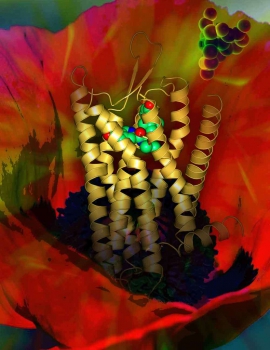Scientists are now one step closer to developing anti-addiction medications, thanks to new research that provides a better understanding of the properties of the only member of the opioid receptor family whose activation counteracts the rewarding effects of addictive drugs. The study was supported by the National Institute on Drug Abuse (NIDA), the National Institute of General Medical Sciences and the National Institute of Mental Health, all components of the National Institutes of Health.
“Drug abuse and addiction remain devastating public health challenges in the United States,” said NIDA Director Dr. Nora D. Volkow. “This research could aid in the development of effective medications for the treatment of drug addiction, particularly to stimulants like cocaine, for which there are no medications currently available. It may also be valuable for the development of safer pain medications.”
 The structure of the kappa-opioid receptor with bound antagonist JDTic is shown resting in a poppy flower, the source of opium. Image by Yekaterina Kadyshevskaya, PSI:Biology GPCR Network, The Scripps Research Institute.
The structure of the kappa-opioid receptor with bound antagonist JDTic is shown resting in a poppy flower, the source of opium. Image by Yekaterina Kadyshevskaya, PSI:Biology GPCR Network, The Scripps Research Institute.Unlike the other opioid receptor subtypes, the kappa opioid receptor (KOR) is not associated with the development of physical dependence or the abuse potential of opiate drugs (e.g., heroin, morphine). Therefore, medications that act at the KOR could have broad therapeutic potential for addressing addiction, pain, as well as other mental disorders. The leading compound in this context is JDTic because its specific binding to the KOR has been shown to reduce relapse to cocaine seeking in animal models.
In this new study, scientists produced a high resolution three-dimensional image of JDTic bound to the human KOR. By mapping all the points of contact between JDTic and the human KOR, researchers were able to see how the two fit together. The emerging picture reveals critical new information that helps explain why JDTic binds so tightly and specifically to this particular opioid receptor. This advance opens the door to the development of compounds targeting the KOR with improved therapeutic profiles, including that of non-addictive pain medications.
The study by Wu et al., can be found at: www.nature.com. For information on prescription drug abuse, go to: www.drugabuse.gov/drugs-abuse/prescription-medications.